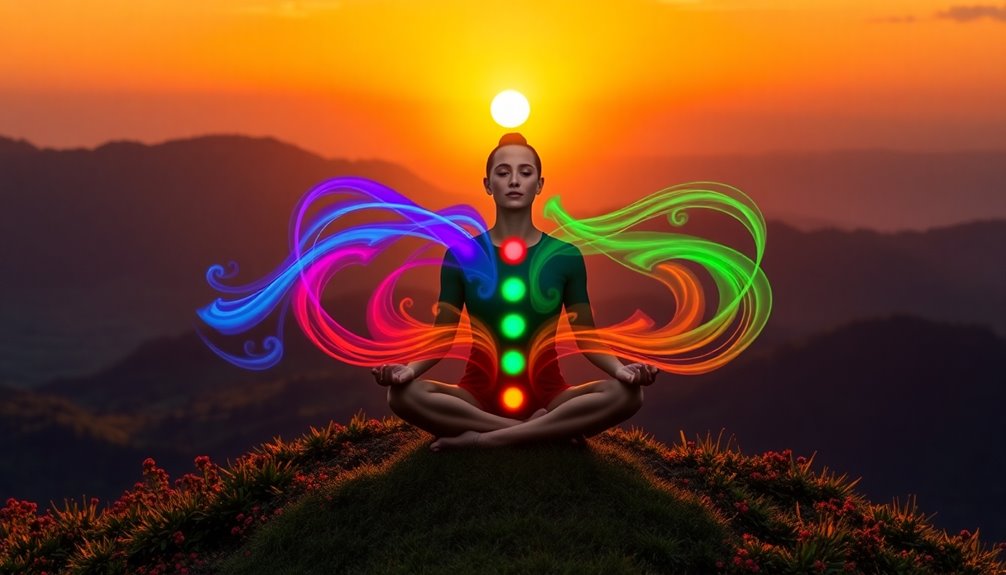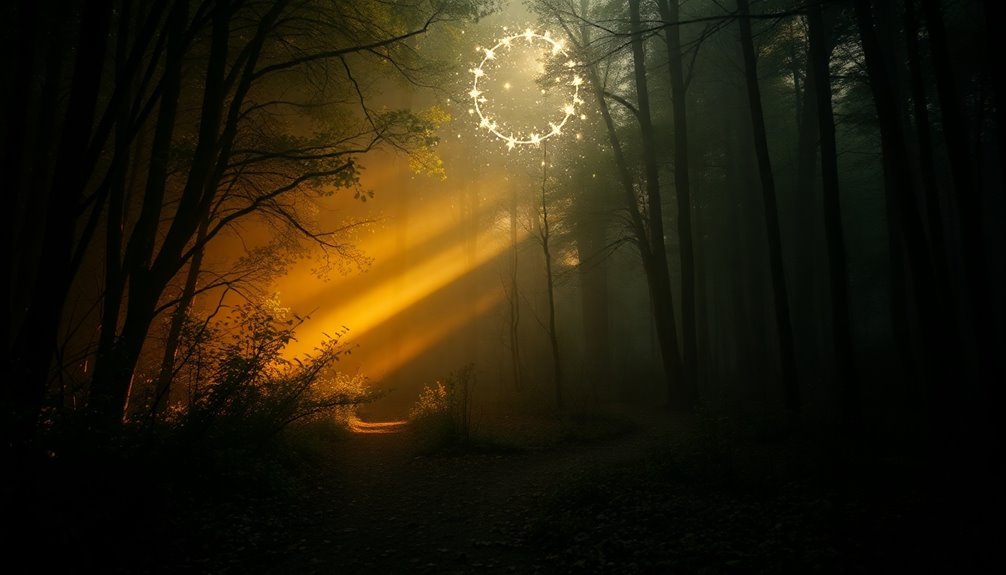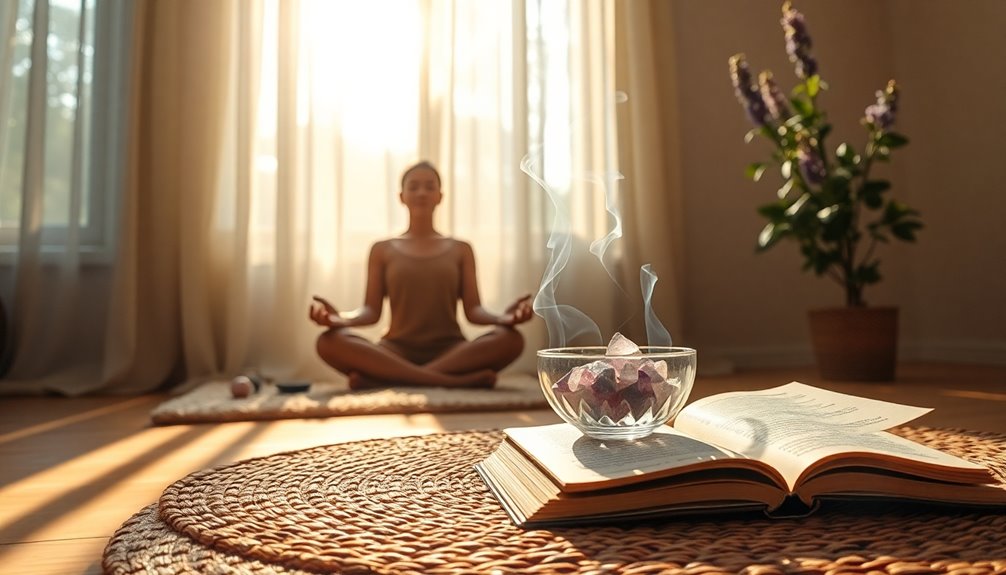Yes, chakras are real energy centers that play a significant role in your physical and emotional well-being. Originating from ancient Indian traditions, they influence your health and personal growth. Many people practice techniques like Kriya Yoga to activate these centers, emphasizing their importance in achieving balance and harmony. However, misconceptions persist about their nature and function, often stemming from translations and modern interpretations. Engaging with chakras requires self-discovery and a personalized approach, fostering deeper connections. If you keep exploring, you'll uncover more about how these energy centers can enhance your life.
Key Takeaways
- Chakras are ancient concepts from Indian traditions, representing energy centers influencing physical and emotional well-being, though interpretations vary widely.
- Modern understandings of chakras often stem from flawed translations and oversimplifications, leading to misconceptions about their nature and function.
- Historical texts highlight that chakras correspond to specific organs and glands, suggesting a link between energy centers and overall health.
- Authentic practices for chakra healing, such as breathwork and meditation, require personal commitment and self-exploration for effective integration.
- Community support and resources are essential for accurate understanding and practice of chakras, promoting informed personal development and spiritual growth.
Historical Context of Chakras
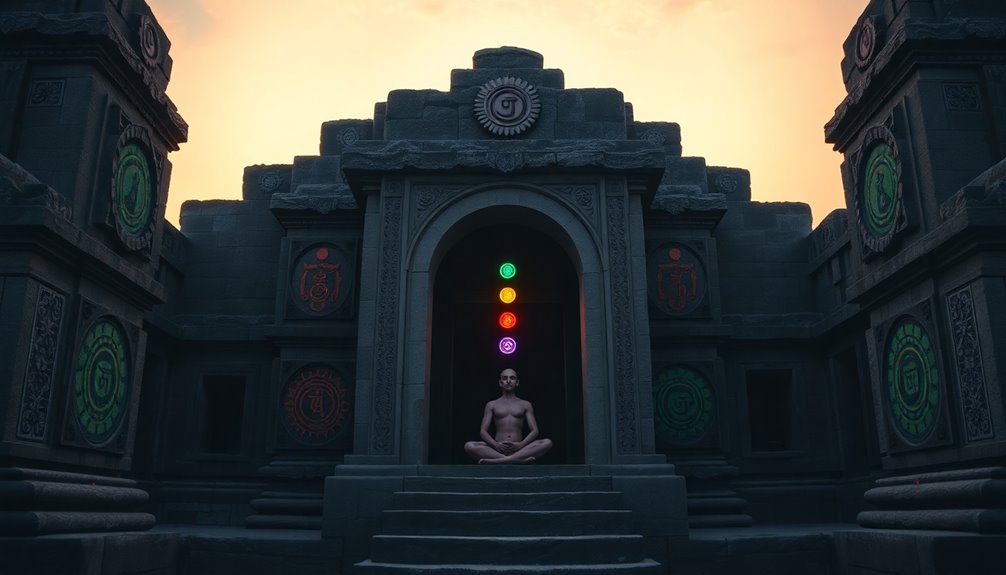
Chakras have a rich historical context that stretches back over 1500 years, primarily rooted in ancient Indian traditions. The concept of the chakra system emerged within the Classical Tantra teachings, where early yogis documented their insights in ancient texts. These writings, dating from the 5th to 12th Century CE, focused on spiritual practices and understanding the energy body, although many have unfortunately been lost to time.
Different schools within the Classical Tantric tradition recognized varying numbers of chakras—five, nine, or even sixteen—indicating that there isn't a universally fixed number. This flexibility reflects the diverse philosophies around spiritual experiences and energy flow.
However, modern interpretations often stem from flawed translations, like Arthur Avalon's mistranslation in "The Serpent Power," leading to widespread misconceptions about chakras.
Interestingly, historical accounts reveal similar concepts in various spiritual traditions, such as the Jewish Menorah, which symbolizes seven energy centers. This interconnectedness highlights how the chakra system transcends cultural boundaries, inviting you to explore the depth of your own spiritual experience.
Understanding this historical context can deepen your appreciation for the intricate tapestry of beliefs surrounding chakras today.
Common Myths Explored
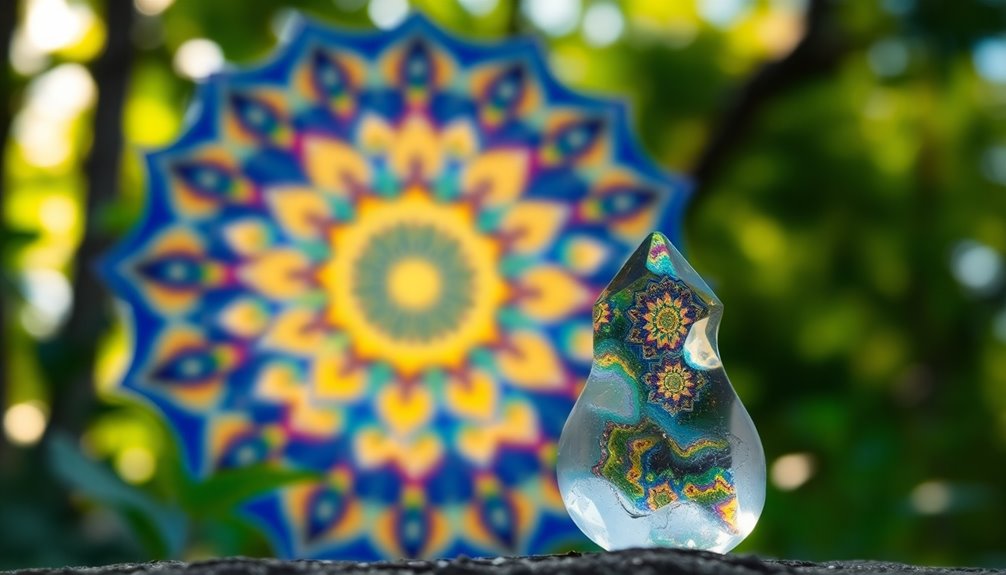
Many people hold misconceptions about chakras that stem from modern interpretations and oversimplifications of ancient teachings. For instance, you might believe there's a fixed number of chakras, but the Classical Tantric tradition recognizes varying counts, such as 5, 9, or even 16, depending on the lineage.
Additionally, the common association of colors with chakras, like the rainbow spectrum, lacks historical evidence and isn't supported by original Tantric texts, which primarily reference red and gold.
You may also think that specific emotions are tied to distinct chakras, a belief largely rooted in Carl Jung's interpretations. This oversimplifies the true complexities of energy and emotions.
Furthermore, the idea of chakra removal or psychic surgeries has no foundation in ancient practices; instead, personal practice and daily Sadhana are emphasized.
Finally, you might hear about Bija mantras and their connection to chakras, but traditionally, these mantras are linked to the five elements, not directly to the chakras.
Recognizing these misconceptions can deepen your understanding of chakras and their real significance in your personal practice.
Chakras and Human Anatomy

Chakras act as energetic centers along your spine, influencing various organs and glands in your body.
For instance, the Third Eye chakra connects to your pineal gland, while the Root chakra is linked to your adrenal glands.
Understanding these connections can help you see how chakras might integrate with your overall anatomy and health.
Energetic Centers Explained
Located along the spine, energetic centers known as chakras play an essential role in your physical and emotional well-being. These chakras would influence your subtle energy, connecting various aspects of your life force. Understanding how they function can empower you to harness your personal power effectively.
Here are four key points about chakras:
- Dynamic Nature: Chakras aren't fixed in number; traditions may recognize five to sixteen, reflecting diverse practices.
- Location & Function: Each chakra corresponds to specific locations along the spine, affecting various organs and systems, like how the Third Eye chakra links to the pineal gland.
- Grounding Energy: The root chakra, at the base of your spine, is vital for grounding and transforming ideas into reality.
- Personal Experience: Engaging with these energetic centers requires personal practice, emphasizing your unique journey with chakra work.
Chakra-Organ Connections
Understanding the intricate connections between chakras and human anatomy reveals how your emotional and physical health intertwine. Each chakra corresponds to specific organs, and recognizing these chakra-organ connections helps you understand how imbalances can affect your well-being.
| Chakra | Associated Organ | Impact on Well-being |
|---|---|---|
| Root Chakra | Adrenal glands | Governs survival and stability |
| Heart Chakra | Heart and lungs | Influences love and emotional health |
| Solar Plexus Chakra | Digestive system | Linked to personal power and self-esteem |
| Third Eye Chakra | Pineal gland | Affects intuition and perception |
For instance, the Heart Chakra not only supports emotional connections but also affects your heart health. Similarly, the Solar Plexus Chakra plays a critical role in digestion and self-worth. When these chakras are balanced, you experience harmony; when they're blocked, it can lead to physical ailments. By understanding these connections, you can work towards emotional healing and better physical health through practices like meditation and yoga.
Healing Practices Overview
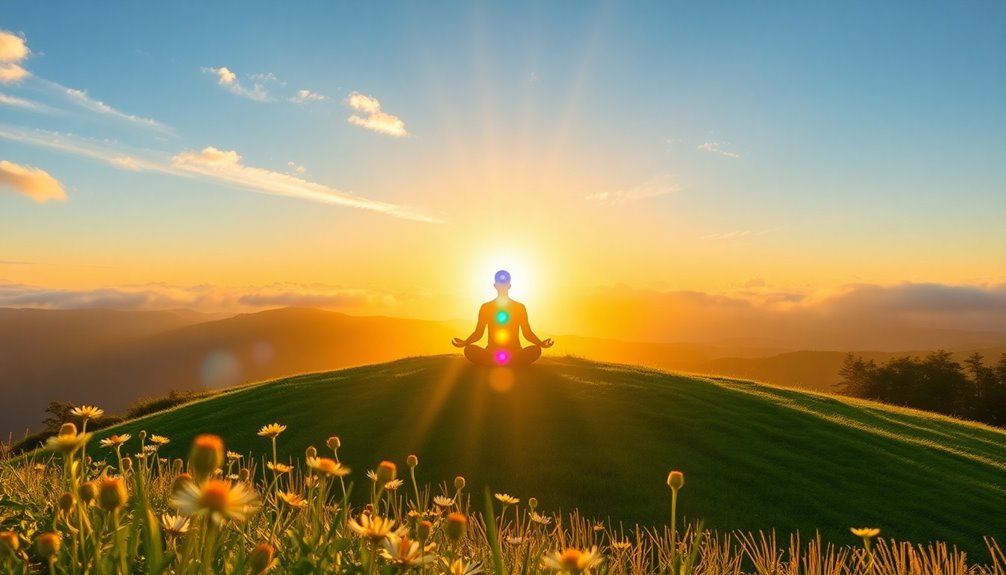
In exploring healing practices related to chakras, you'll find a rich tapestry of techniques like breathwork, visualization, and mantra recitation, all deeply rooted in ancient Tantric traditions.
Authentic chakra healing emphasizes personal daily Sadhana practices and self-discipline. This approach contrasts sharply with unverified claims of chakra removal or psychic surgeries.
When working with the chakras, consider incorporating the following elements into your healing practices:
- Breathwork: Use conscious breathing to center your energy and connect with your chakras.
- Vital Oils: Experiment with oils corresponding to specific chakras to enhance your practice.
- Visualization: Create vivid mental images of the chakras to aid in balancing your energy.
- Mantra Recitation: Incorporate bija mantras to connect with the five elements rather than directly linking them to the chakras.
Engaging with chakras can lead to profound insights and emotional understanding.
However, it's crucial to explore these practices gradually to avoid overwhelming experiences.
Resources for Further Learning
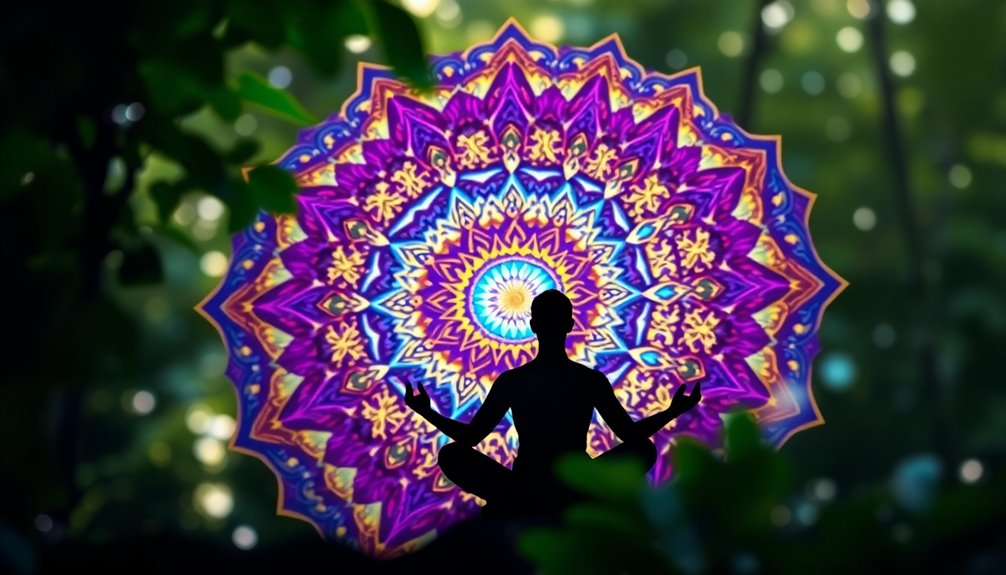
If you're looking to deepen your understanding of chakras, consider exploring recommended books and authors that critically examine the topic.
Online courses and workshops can offer structured learning and community support networks will help you connect with others on this journey.
Engaging with these resources can enhance both your knowledge and personal experience with chakra work.
Recommended Books and Authors
Exploring the world of chakras can be both enlightening and complex, especially when sifting through various interpretations and teachings.
To gain a better understanding of chakras and their significance in essential life, consider diving into these recommended books:
- The Serpent Power by Arthur Avalon – Although it popularized chakras, be cautious of its flawed concepts arising from mistranslations of Sanskrit texts.
- The Yoga of the Hidden Goddess by Christopher Hareesh Wallis – This contemporary work provides authentic insights into chakras and their teachings, ideal for modern readers.
- Kundalini: The Evolutionary Energy in Man by Gopi Krishna – A personal account of spiritual awakening associated with chakras, offering a unique perspective on this transformative journey.
- The Chakra Bible by Patricia Mercier – A practical guide that includes exercises and meditations, perfect for anyone looking to balance and activate their chakras.
For a scholarly perspective, check out The Tantric Tradition by Christopher Tompkins.
It explores the historical context of chakras within Classical Tantra, providing deeper insights into their significance in ancient practices.
Happy reading!
Online Courses and Workshops
Online courses and workshops offer a dynamic way to deepen your understanding of chakras and their practices. Extensive programs like The Light Collective Method provide in-depth insights into chakra systems, emphasizing authentic teachings rooted in Classical Tantra. You can explore enriching workshops led by scholars such as Christopher Hareesh Wallis and Christopher Tompkins, who offer valuable perspectives on the evolution of these systems.
Many online platforms also present accessible resources, including video lectures and guided meditations that focus on traditional practices. Here's a quick overview of the types of resources available:
| Resource Type | Description |
|---|---|
| Online Courses | Structured learning with in-depth material |
| Workshops | Interactive sessions with expert insights |
| Guided Meditations | Practical exercises for personal practice |
Participating in these online courses and workshops not only enhances your knowledge but also connects you with a community of learners. Engaging in discussions and forums can offer diverse viewpoints, enriching your experience. Regular webinars keep you updated with accurate methodologies related to chakra work, ensuring you stay informed and inspired.
Community Support Networks
Community support networks play an essential role in enhancing your understanding of chakras and their practices. By connecting with others, you can deepen your knowledge of chakra teachings and dispel common myths.
Here are some ways you can engage with these networks:
- Join local yoga studios – Participating in classes can lead to discussions about chakra work and provide firsthand experiences.
- Engage in online forums – Platforms like Reddit or Facebook groups allow you to share your experiences and learn from others' insights.
- Attend workshops and retreats – These events often feature experienced teachers who offer guidance and foster a supportive environment for exploring authentic chakra practices.
- Read reputable literature – Seek out books and articles by scholars like Christopher Hareesh Wallis and Christopher Tompkins, who clarify the historical context of chakras.
Importance of Self-Study
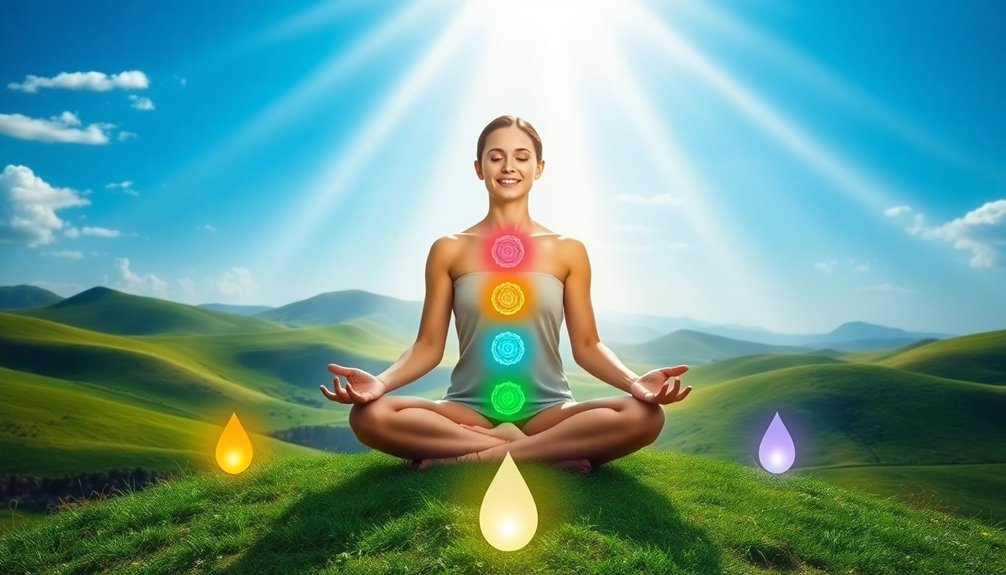
Self-study, or Svadhyaya, plays an important role in personal development and spiritual growth. By engaging in self-study, you can reflect on your beliefs, values, and motivations, which enhances your self-awareness and emotional intelligence. This practice allows you to identify negative patterns in your life, promoting accountability and personal responsibility.
To apply self-study effectively, consider daily journaling, guided meditations, or discussions on spiritual texts. These activities foster deeper insights and understanding of yourself, leading to transformative spiritual growth. Svadhyaya strengthens your spiritual connections and equips you to navigate life's challenges with greater clarity and purpose.
Cultivating self-love and humility is essential in this journey. Approaching your growth with kindness and an open heart makes it easier to embrace your strengths and weaknesses.
Remember, self-study isn't just about gaining knowledge; it's about fostering a deeper connection with your inner self. Engaging in this practice can enhance your self-awareness and help you better understand your emotional triggers.
As you commit to this practice, you'll likely find that the path to self-discovery becomes clearer and more fulfilling. Embrace Svadhyaya as an important tool in your life, guiding your journey toward enhanced self-awareness and meaningful spiritual growth.
Kriya Yoga and Spiritual Growth

Engaging in self-study naturally leads you to explore various spiritual practices, one of which is Kriya Yoga. This thorough approach combines meditation, breathing techniques, and self-discipline to accelerate your spiritual growth.
Central to Kriya Yoga is the awakening of Kundalini Shakti, the dormant energy at the base of your spine. When activated, this energy promotes heightened states of consciousness and the awakening of your chakras.
To fully embrace Kriya Yoga and its benefits, consider these four key aspects:
- Dedicated Practice: Consistent practice is essential for balancing your chakras and enhancing spiritual growth.
- Personal Journey: Each individual's path is unique; you don't need to open all chakras simultaneously.
- Mind-Body Connection: Kriya Yoga strengthens the connection between your mind, body, and spirit, promoting overall well-being.
- Progressive Activation: Chakra activation occurs gradually through dedication, encouraging continuous self-discovery and development.
Frequently Asked Questions
Is Chakra Scientifically Proven?
Chakras aren't scientifically proven in the way physical phenomena are.
While some studies suggest links between emotional states and physical health, these connections remain mostly anecdotal. You might find that practices related to chakras resonate with your experiences, but the specific framework hasn't been rigorously tested.
Emerging fields like biofield science explore energy's role in health, yet the concept of chakras as defined in ancient traditions lacks empirical evidence.
What Does Jesus Say About Chakras?
Jesus doesn't explicitly talk about chakras, but his teachings about love and inner awareness can make you feel like you're revealing the universe's secrets.
When you immerse yourself in the Heart Chakra, you'll find a connection to his messages about compassion and connection with others.
Exploring your energy centers aligns beautifully with his call for personal spiritual experiences.
Embracing this journey can lead to a more harmonious relationship with yourself and the divine.
Is the Concept of Chakra Real?
The concept of chakras is real in the sense that they represent energetic centers linked to your physical and emotional well-being.
You can explore these centers through practices like yoga and meditation, enhancing your self-awareness and spiritual growth.
While interpretations vary, working with chakras can provide you insight into your emotional state.
Ultimately, your experience with chakras can offer a deeper understanding of yourself and your spiritual journey.
Which Chakra Is Associated With Truth?
You might find it interesting that the blue sky often inspires creativity and communication.
This is exactly what the Throat Chakra, or Vishuddha, embodies. Located at your throat, it's all about truth and self-expression.
When balanced, you'll articulate your thoughts clearly and foster genuine connections.
However, if it's blocked, you may struggle to voice your feelings.
Embracing this chakra can help you embrace your truth and communicate it effectively.
Conclusion
To sum up, while the existence of chakras may spark debate, their influence on wellness is undeniable. Did you know that over 60% of people report feeling more balanced and centered after practicing chakra meditation? This statistic shows the potential impact of these ancient concepts on modern life. Exploring chakras can lead to personal growth and healing, encouraging you to dive deeper into your own journey of self-discovery. Embrace the mystery and see where it takes you!

